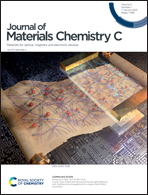Blue-emitting butterfly-shaped donor–acceptor-type 1,3,5,9-tetraarylpyrenes: easily available, low-cost conventional fluorophores for high-performance near ultraviolet electroluminescence with CIEy < 0.05†
Abstract
Exploring the near ultraviolet (NUV) emitters with excellent electroluminescence performance is a crucial issue for high-density information storage, high-quality flat-panel displays and high-quality solid-state lighting. In this paper, three blue-emitting butterfly-shaped donor–acceptor (DA)-type pyrene-based emitters (3a–c) with a 1,3-A/5,9-D molecular structure have been successfully designed and synthesized by an easily available, low-cost method. All three compounds have conventional fluorescence characteristics with strong NUV emission both in solution and in thin film, and have good thermal stability, which meets the preparation basis of NUV organic light-emitting diodes (OLEDs). With the DA pyrenes (3a–c) as dopants, CBP-based OLED devices exhibit maximum EQEs of ∼3.0% with CIE coordinates with y < 0.05, which are remarkable compared to the reported NUV OLEDs with a similar color gamut. This is the first demonstration of using DA pyrenes as high efficiency NUV emitters in fluorescent OLEDs. Furthermore, employing 3c as a representative host, the DSA-Ph-doped sky-blue device displays a low turn-on voltage of 2.6 V and a maximum EQE, current efficiency (CE) and luminance of 6.84%, 12.95 cd A−1 and 13 954 cd m−2, respectively, which are comparable to the most advanced blue hosts such as MADN. This study not only demonstrates the potential of the present DA pyrenes in NUV OLEDs, but also provides tactics for the rational design of blue emitters by using the DA pyrene-based architecture.



 Please wait while we load your content...
Please wait while we load your content...